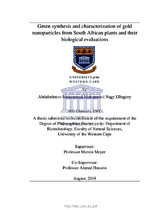| dc.description.abstract | The field of nanotechnology continues to offer solutions for biotechnologists whose
target is to improve the quality of life by finding new therapies to combat diseases.
Gold nanoparticles (AuNPs) have been showing great potentials in many biomedical
applications. The antibacterial activity of the AuNPs presents a therapeutic option for
conditions caused by bacterial infections such as chronic wounds. Also, these versatile
particles can offer solutions in the treatments of infectious diseases and can also be
exploited as “smart” vehicles to carry drugs, such as antibiotics, for improved
efficiency. Moreover, the anti-inflammatory activity of AuNPs makes them useful in
the management of prolonged inflammation caused by bacterial infections.
The synthesis of AuNPs can be achieved by variety of physical and chemical methods
that have been successfully applied in labs and industry. Nonetheless, the drawbacks
of these “conventional” methods in terms of high cost, adverse health side effects and
incompatibility with the ecosystem cannot be overlooked. Thus, new safer and more
cost-effective protocols have been reported for the synthesis of AuNPs. Plants have
provided alternate synthesis methods in which the reducing capabilities of the
phytochemicals, found in the aqueous plant extracts, can be used to chemically
synthesize AuNPs from gold precursors.
The biosynthesis and characterization of AuNPs from the phytochemicals of several
South African plants is investigated in this study. The study also reports the
optimization of the AuNPs biosynthesis by varying reaction conditions such as
temperature and plant extracts’ concentrations. Furthermore, the study highlights the
wound healing activity of the AuNPs synthesized from selected plants by investigating
their antibacterial activity on bacterial strains known to cause chronic wounds. The
ability of these AuNPs to carry ampicillin in order to enhance the antibacterial activity
is also described herein. The cytotoxicity of the biosynthesized AuNPs was evaluated on human normal fibroblasts cells (KMST-6). Additionally, the immunomodulatory
effect of the biosynthesized AuNPs on the cytokines production from macrophages and
Natural Killer (NK) cells was examined.
The study was successful to produce biocompatible and safe AuNPs synthesized from
the tested aqueous plant extracts. The resulted AuNPs showed different
physicochemical properties by varying the reaction conditions. The AuNPs exhibited
antibacterial activity against several Gram-positive and Gram-negative bacteria. Also,
ampicillin was successfully loaded on the biosynthesized AuNPs, which led to the
formation of more antibacterial active conjugated AuNPs compared to the free AuNPs.
The green synthesized AuNPs were also found to have anti-inflammatory responses as
shown by the reduction of pro-inflammatory cytokines from immune cells. In vitro
assays showed that the biogenic AuNPs were not toxic to KMST-6 cells. Overall, the
data suggest that plant extracts produce biologically safe AuNPs with antibacterial and
anti-inflammatory activities that can be exploited in the treatment of chronic wounds
and in the management of chronic inflammation. | en_US |

